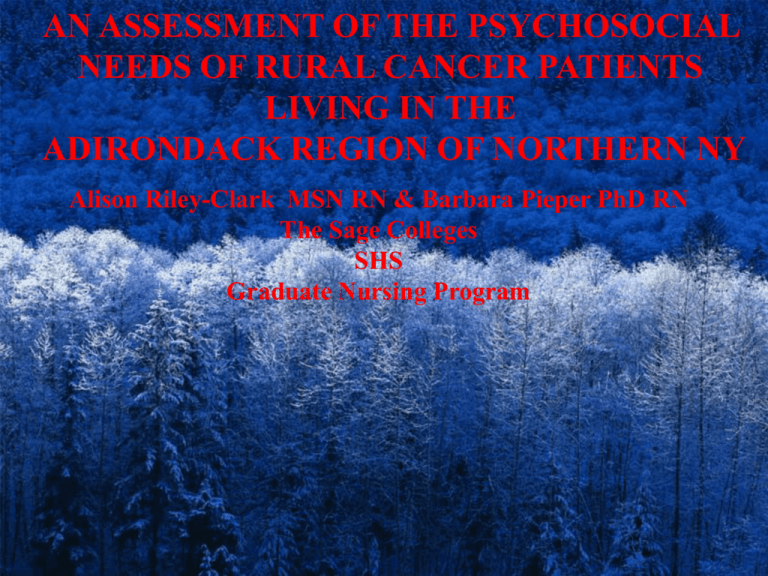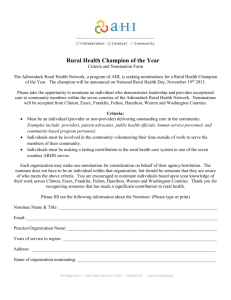L Riley Clark
advertisement

AN ASSESSMENT OF THE PSYCHOSOCIAL NEEDS OF RURAL CANCER PATIENTS LIVING IN THE ADIRONDACK REGION OF NORTHERN NY Alison Riley-Clark MSN RN & Barbara Pieper PhD RN The Sage Colleges SHS Graduate Nursing Program RURAL AREAS: RECURRING THEMES Unique demographics and needs Have shortages of health care providers and cancer specialists (Hughes, Ingleton, Noble & Clark, 2004) “Although 20 % of Americans live in rural areas only 9% of MD’s practice there” (AHRQ, 2004) Medicare reimbursements are lower for rural hospitals for the same services. (Ricketts, 2000) Higher percentage of residents >65, more patients on Medicare, less revenues Population has lower income and education levels (National Rural Health Association, 2008) Transportation difficulties Isolated communities Lack of hospitals & home health services (Baltic,Whedon, Ahles & Funciullo, 2002) Limited Internet and cell phone access HOSPITALS IN THE ADIRONDACK PARK Adirondack Medical Center, Franklin Co. 97 beds, cancer clinic with visiting oncologist 2 days per week Elizabethtown Hospital, Essex Co. 15 beds, just added chemotx services Alice Hyde Medical Center, Franklin Co. 76 beds. Cancer clinic, oncologist and radiation therapy services HAMILTON COUNTY HAS NO HOSPITAL Residents Over 65 Years by County Essex County – 16.7% Franklin County – 13.2% Hamilton County – 21.5% New York State – 13.2% US Census, 2000 PURPOSE OF THE STUDY Describe the self reported psychosocial needs of rural cancer patients living in the Adk region. Identify barriers that prevent rural cancer patients from accessing available services. Data will be used to plan new programs for Adirondack cancer patients by local and state cancer providers. Add to the literature on the needs of rural cancer patients RESEARCH QUESTIONS What are the self-reported psychosocial needs of rural Adirondack cancer patients? Do these patients have access to cancer services and if not, what are the barriers to obtaining quality care and services? What services do patients want to have available? What percent of patients have access to computers & online services? What methods do patients prefer to get more information about their disease ? SURVEY TOOL Designed by researchers Brief, only 3-5 minutes to complete 7 Demographic questions 8 Likert scale questions Checklist of preferred services Checklist for info delivery methods Comment section METHODS *Survey Distribution Adirondack Medical Center Oncology Center Local ENT Physician Office Cancer Support Group Meetings *Staff gave patients survey, a pen and an envelope. *Respondents placed the completed survey in the envelope and then in a locked collection box. *Study approved by IRB at The Sage Colleges Demographic Variables 32 Percent 19 28 40.4% 59.6% Live in the Adirondack Park 46 97.9% Race - White (as identified by respondent) Type of Cancer 46 97.9% Breast 13 27.7% Colon 3 6.4% Lung 2 4.3% Other or multiple types 19 40.4% Currently Receiving Cancer Treatment 68.1% Gender Male Female Table 2 Travel Time to Medical Services in Minutes. Family Doctor N 47 Mean 13.11 SD 12.64 Range 0-60.00 Cancer Doctor 47 60.32 105.77 0-480.00 Chemotherapy 47 20.11 35.91 0-150.00 Radiation Therapy 47 27.87 37.98 0-150.00 Characteristics (n=46) 97.9% never had missed an appointment due to difficulty getting a ride, buying gas or car problems. 81% have Internet access 19% have no Internet access 13% never use Internet for information 47% had attended a support group. 72% expressed some interest to very interested in attending a support group. 47% felt scared, anxious, sad or worried several times a month, weekly or daily. SURVEY QUESTION 1 NEVER/NOT AT ALL How often do you feel Scared, anxious, sad or worried? 10.6% (n=5) 42.6% 21.3% 12.8% (n=20) (n=10) (n=6) 12.8% (n=6) 4.3% (n=2) 6.4% (n=3) 12.8% 12.8% (n=6) (n=6) 61.7% ( n=29) 8.5% 27.7% (n=4) (n=13) 2.1% (n=1) How often do you get support from family and friends How often do you get help from your church or any community organization? 2 3 WKLY/VERY INTERESTED 53.2% (n=25) 6.4% (n=3) Have you ever been interested in talking with a counselor about coping with cancer? 42.6% (n=20) 21.3% 25.5% 8.5% (n=4) (n=10) (n=12) How interested are you in trying yoga or relaxation classes? 36.2% (n=17) 12.8% (n=6) 17% 31.9% (n=17) (n=15) 5 DAILY Services patients preferred to help deal with their cancer. Respondent’s Preferred Methods For Cancer Information 70 59.6 60 48.9 50 Percentage 40.4 40 30 20 14.9 10 0 Method 17 12.8 10.6 RECOMMENDATIONS Explore providing laptop computers/epads with Internet access during treatments. Locate and apply for additional grant funding for yoga/guided imagery/massage sessions Expand availability of counseling and education specific to coping with cancer & stress. Expand support group services and explore strategies to connect patients to each other. Continue to provide written educational materials as well as print-outs/computer discs from cancer websites for those without access Explore using ebooks and enlarging patient lending library. QUESTIONS? Contact Information Alison Riley-Clark 518-523-2212 arclark59@gmail.com References American Society of Clinical Oncology. (2006, May). Organizations collaborate to improve the quality of cancer care. Journal of Oncology Practice, 2 (3). Retrieved on line from http://qualityalliance.stateaffiliates-asco.org/jop.pdf Baltic, T., Whedon, M.B., Ahles, T., & Fanciullo, G..( 2002). Improving pain relief in a rural cancer center. Cancer Practice, 10, Ps39S44. Braveman, P. (2007). Do we have real poverty in the United States of America? Preventing Chronic Disease, 4 (4) p. 1-2. Retrieved from www.cdc.gov Celaya, M., Rees, J., Gibson, J., Riddle, B. & Greenberg, E.. (2006) Travel distance and season of diagnosis affect treatment choices for women with early-stage breast cancer in a predominantly rural population (United States). Cancer Causes Control 17, p. 851-856. Desch, C., Smith, T., Breindel, C. & Simonson, C.. (1992). Cancer treatment in rural areas. Hospital & Health Services Administration, 37(4), 449-463. Franzak, F., Smith, T. & Desch, C. (1995) Marketing cancer care to rural residents. Journal of Public Policy & Marketing, 14 (1) 7687. Hughes, P., Ingleton, M., Noble, B. & Clark, D. (2004) Providing cancer and palliative care in rural areas: a review of patient and carer needs. Journal of Palliative Care, 20 (1) p. 44-49. Hartley, D. & Gale, J. (n.d.) Rural health care safety nets. Retrieved from Agency of Health Research and Quality website: http://www.ahrq.gov/data/safetynet/hartley.htm Health Care Disparities in Rural Areas: Selected Findings from the 2004 National Healthcare Disparities Report. AHRQ Publication No. 05-P022, May 2005. Agency for Healthcare Research and Quality, Rockville, MD. http://www.ahrq.gov/research/ruraldis/ruraldispar.htm Ide, B. (2000) Rural Practice Forum: understanding rural health care. Online Journal of Rural Nursing and Health Care, 1 (1), Spring 2004. Im, E., Chee, W., Guevara, E., Lim, H., & Shin, H.. (2008). Gender and ethnic differences in cancer patients’ needs for help: an internet survey. International Journal of Nursing Studies, 45, 1192-1204. Improving Health Care for Rural Populations. Research in Action Fact Sheet. AHCPR Publication No. 96-P040, (March 1996). Agency Lantz, P., House, J., Lepkowsi, J., Williams, D., Mero, R. & Chen, J. (1998). Socioeconomic factors, health behaviors and mortality. JAMA, 279 (21) p1703-1708. Lewis, L. (2006). Discussion and recommendations: addressing barriers in the management of cancer survivors. American Journal of Nursing, 106 (3) p 91-95. Metzler, M. (2007). Social determinants of health: what, how, why, and now. Preventing Chronic Disease, 4 (4) p. 1-3. Retrieved from www.cdc.gov Raghavan, d. (2007). Disparities in cancer care: challenges and solutions. Oncology, 21 (4) p. 493-496. Shugarman, L.R., Sorbero, M.E.S., Tian, H., Jain, A.K., & Ashwood, J.S.. (2008). An exploration of urban and rural differences in lung cancer survival among Medicare beneficiaries. American Journal of Public Health, 98, 1280-1287. Doi:10.2105/AJPH.2006.099416 The adironack rural health network service area and community. (2008) Retrieved from the Adirondack Rural Health Network: Http://www.arhn.org/ourregion United States Census Bureau. What is the difference between rural and urban population? Retrieved on June 23, 2008 from:www.cdc.gov Wen, J.,& Gustafson, D.. (2004) Needs assessment for cancer patients and their families. Health and Quality of Life Outcomes, 2, 11-23. Retrieved from http://www.hqlo.com/content/2/1/11 What’s different about rural health care? (2007-2008) Retrieved from the National Rural Health Association Website: http://www.ruralhelathweb.org/go/left/abut-rural-health/what-s-different-about-rural-health What is rural? (n.d.) Retrieved from the Rural Assistance Center website: http://www.raconline.org/info_guides/ruraldef/ Younis, M. (2003) A comparison study of urban and small rural hospitals financial and economic performance. Online Journal of Rural Health Nursing and Health Care, 3(1) Spring, 2003.





